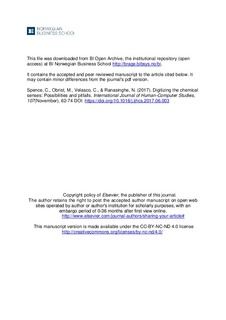Digitizing the chemical senses: Possibilities & pitfalls
Journal article, Peer reviewed
Accepted version
Permanent lenke
http://hdl.handle.net/11250/2453800Utgivelsesdato
2017Metadata
Vis full innførselSamlinger
- Publikasjoner fra CRIStin - BI [1015]
- Scientific articles [2181]
Originalversjon
International Journal of Human-Computer Studies, 2017, 107(November), 62-74 10.1016/j.ijhcs.2017.06.003Sammendrag
Many people are understandably excited by the suggestion that the chemical senses can be digitized; be it to deliver ambient fragrances (e.g., in virtual reality or health-related applications), or else to transmit flavour experiences via the internet. However, to date, progress in this area has been surprisingly slow. Furthermore, the majority of the attempts at successful commercialization have failed, often in the face of consumer ambivalence over the perceived benefits/utility. In this review, with the focus squarely on the domain of Human-Computer Interaction (HCI), we summarize the state-of-the-art in the area. We highlight the key possibilities and pitfalls as far as stimulating the so-called ‘lower’ senses of taste, smell, and the trigeminal system are concerned. Ultimately, we suggest that mixed reality solutions are currently the most plausible as far as delivering (or rather modulating) flavour experiences digitally is concerned. The key problems with digital fragrance delivery are related to attention and attribution. People often fail to detect fragrances when they are concentrating on something else; And even when they detect that their chemical senses have been stimulated, there is always a danger that they attribute their experience (e.g., pleasure) to one of the other senses – this is what we call ‘the fundamental attribution error’. We conclude with an outlook on digitizing the chemical senses and summarize a set of open-ended questions that the HCI community has to address in future explorations of smell and taste as interaction modalities
Beskrivelse
The accepted and peer reviewed manuscript to the article
